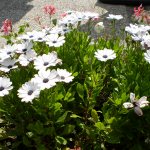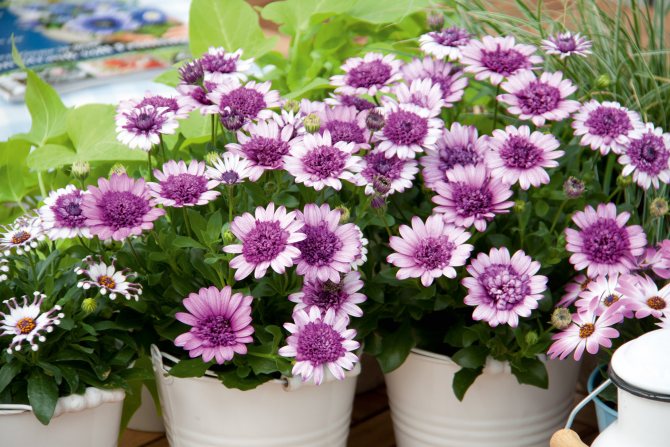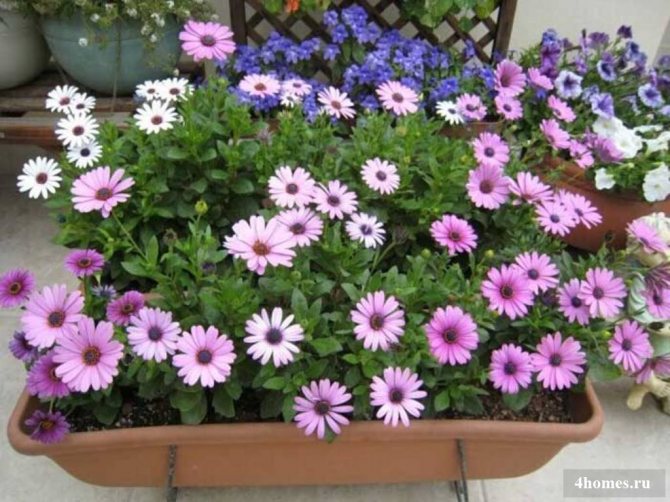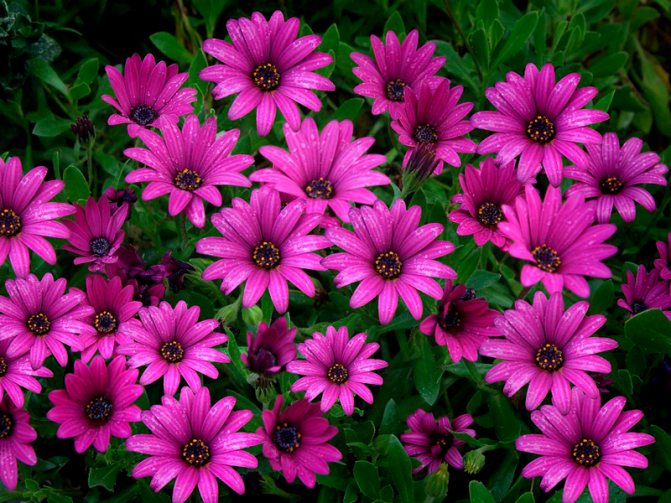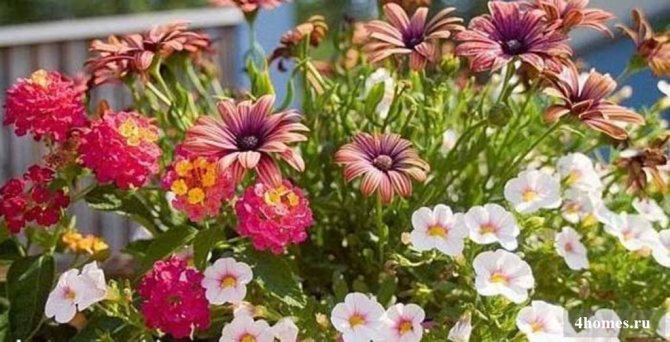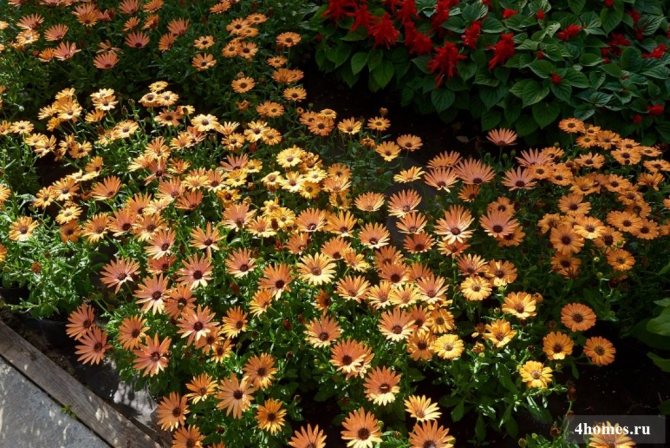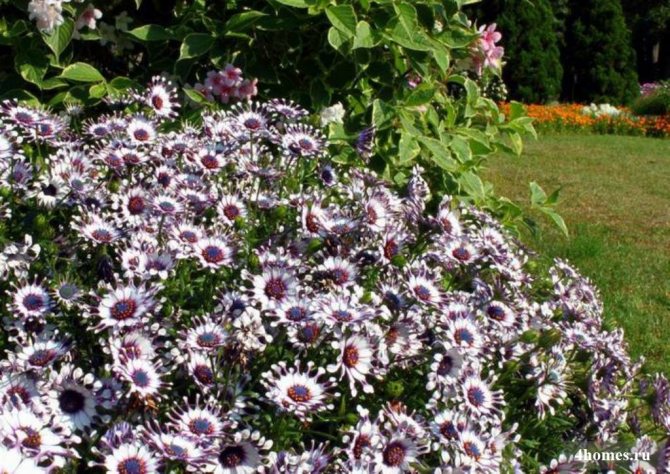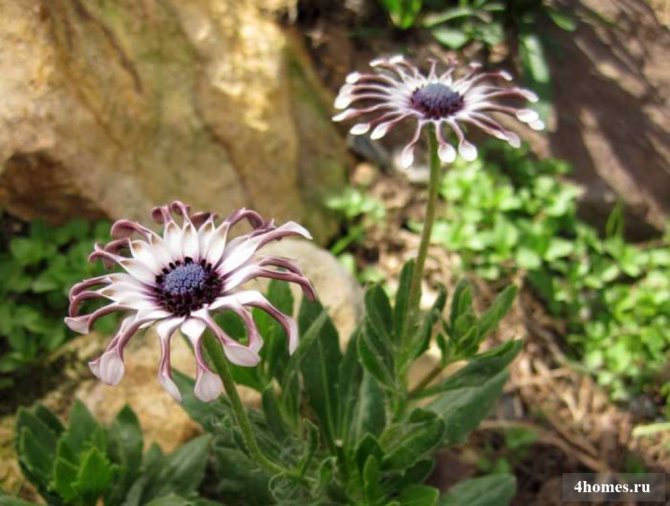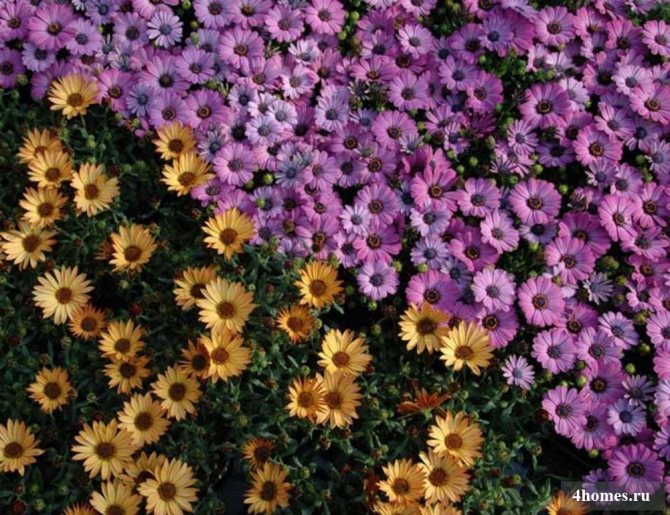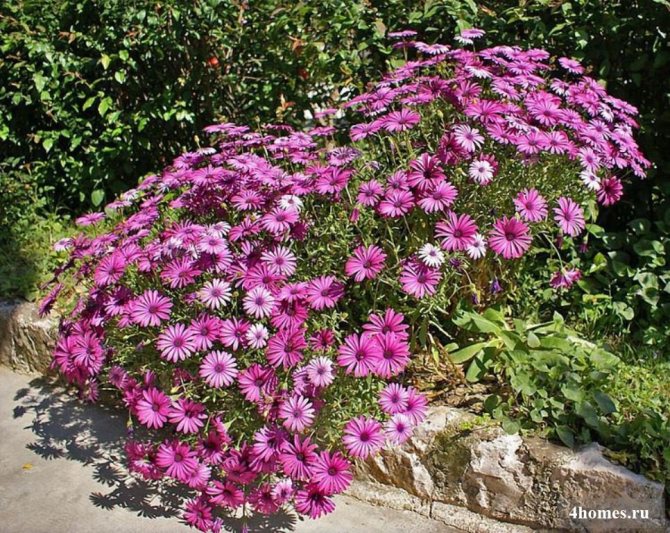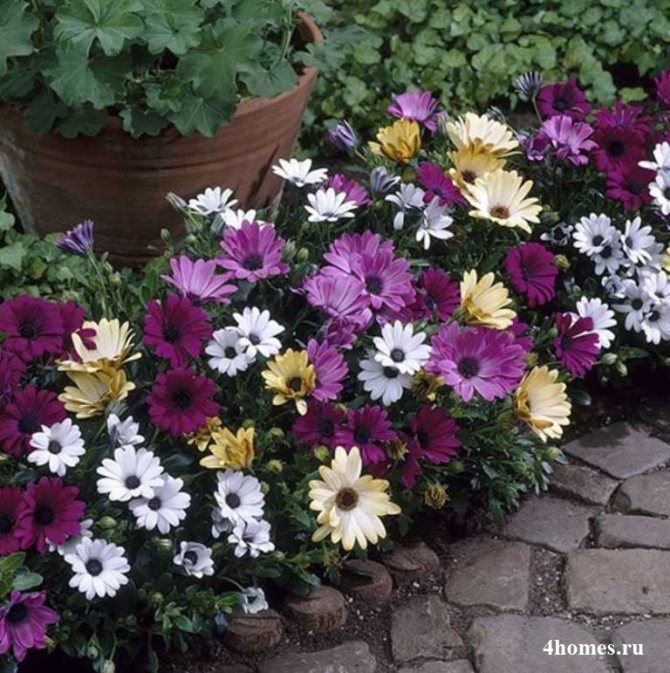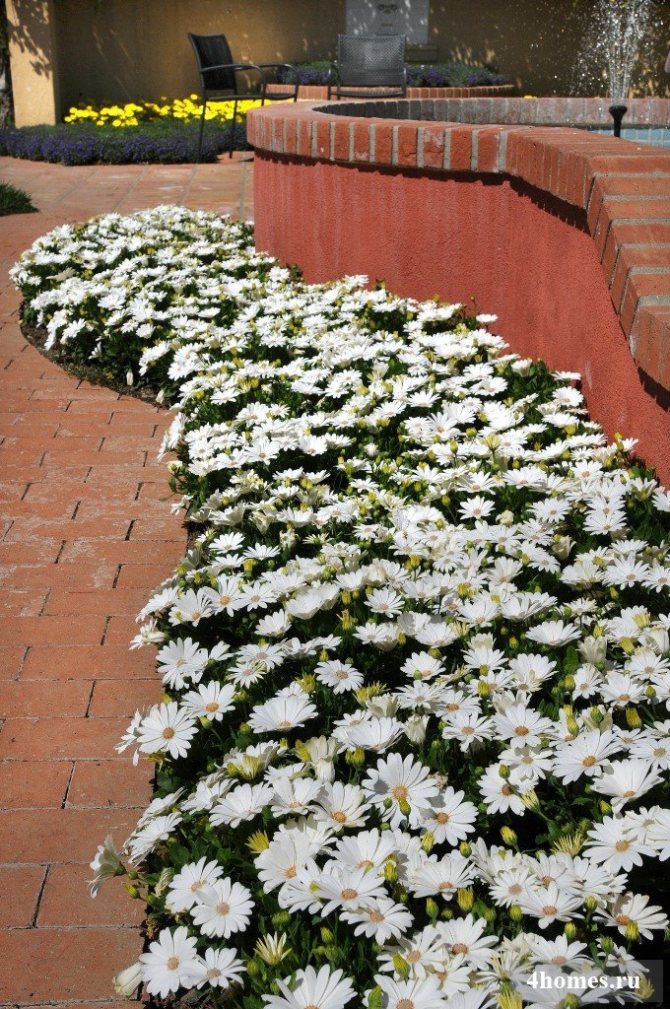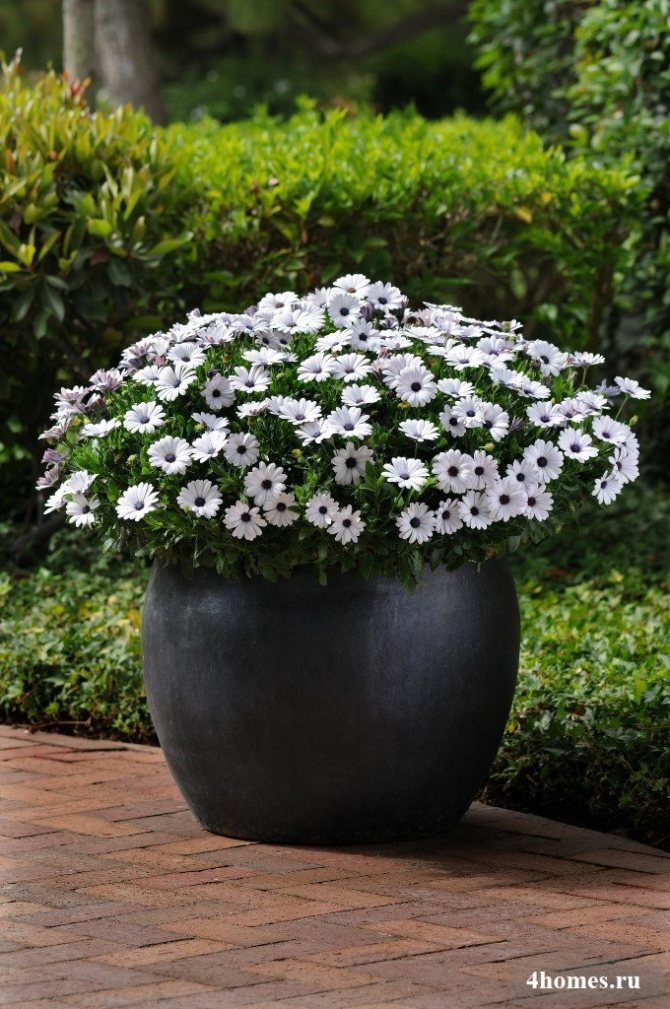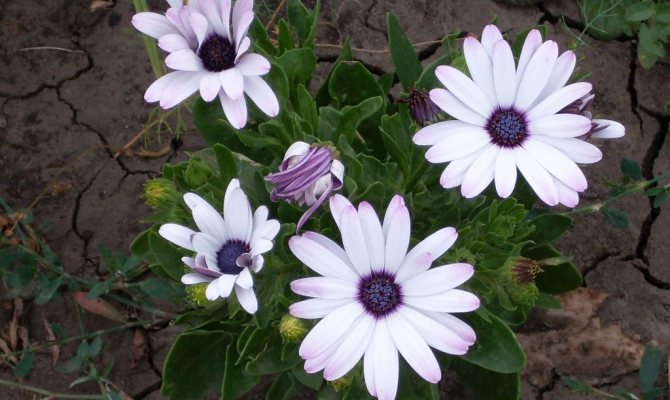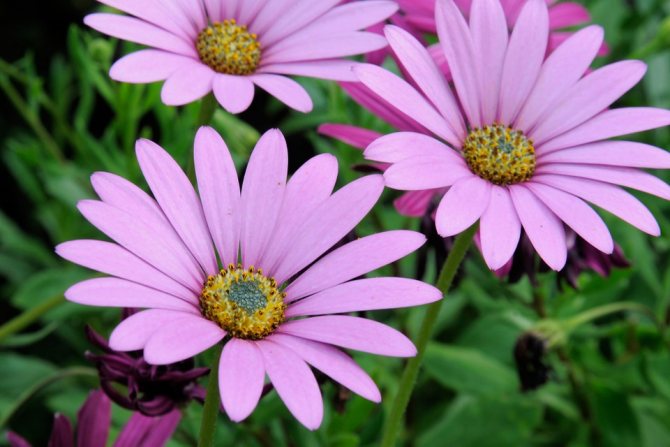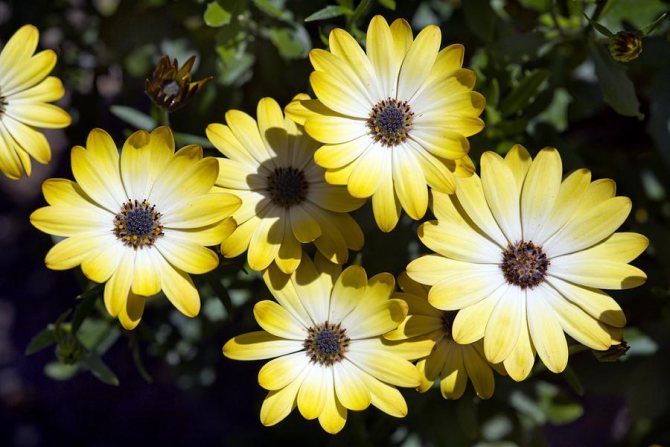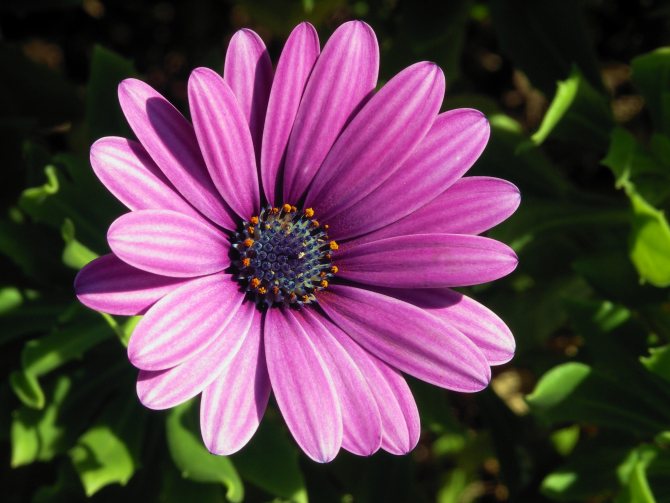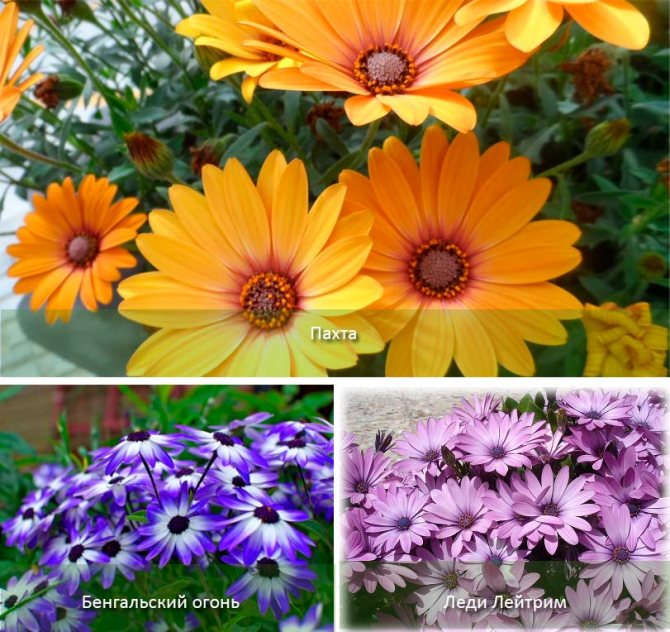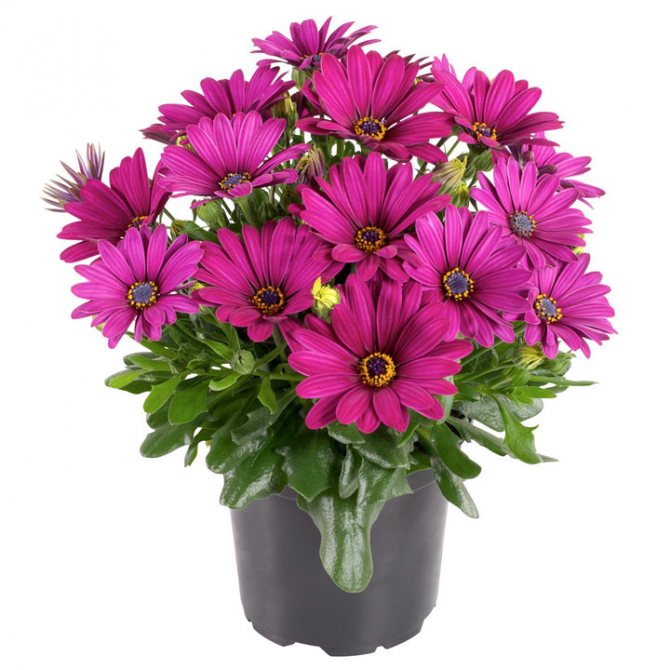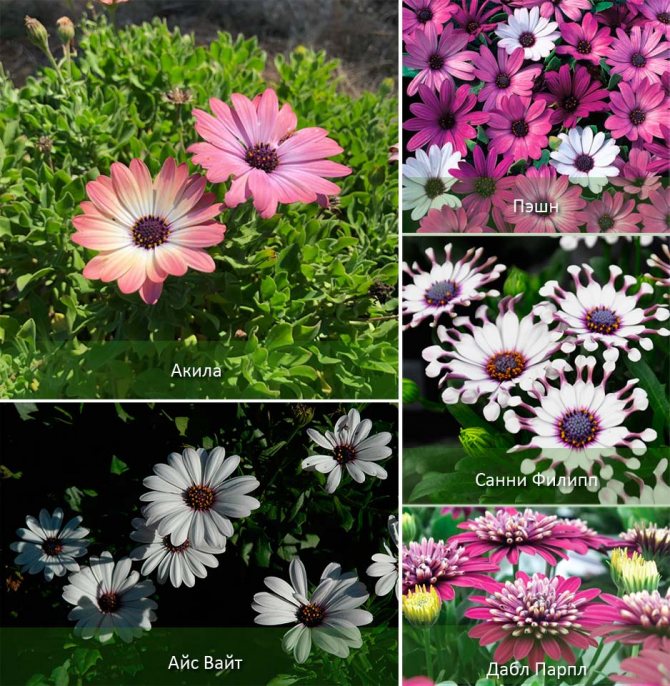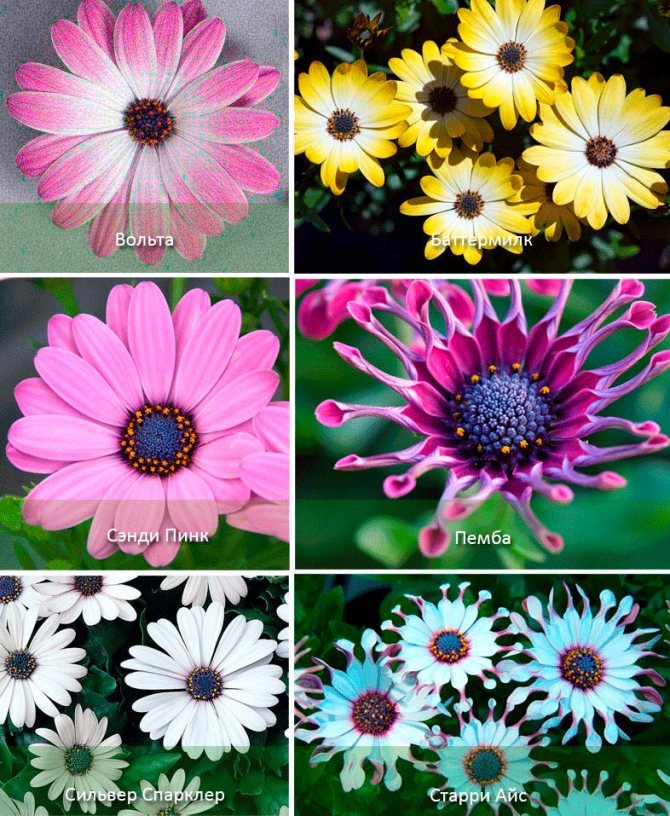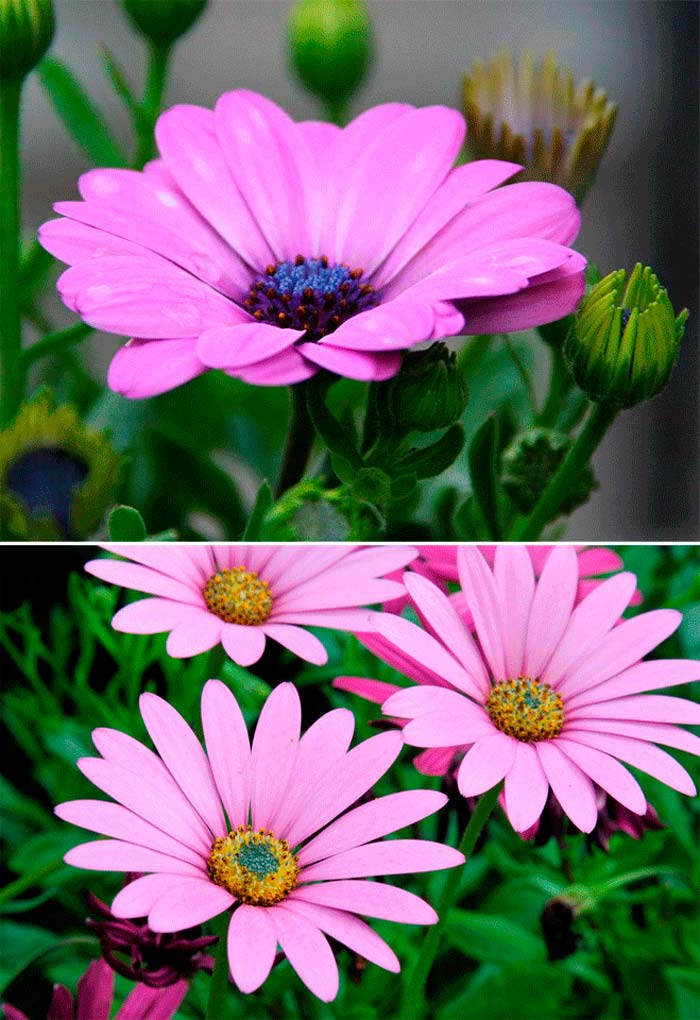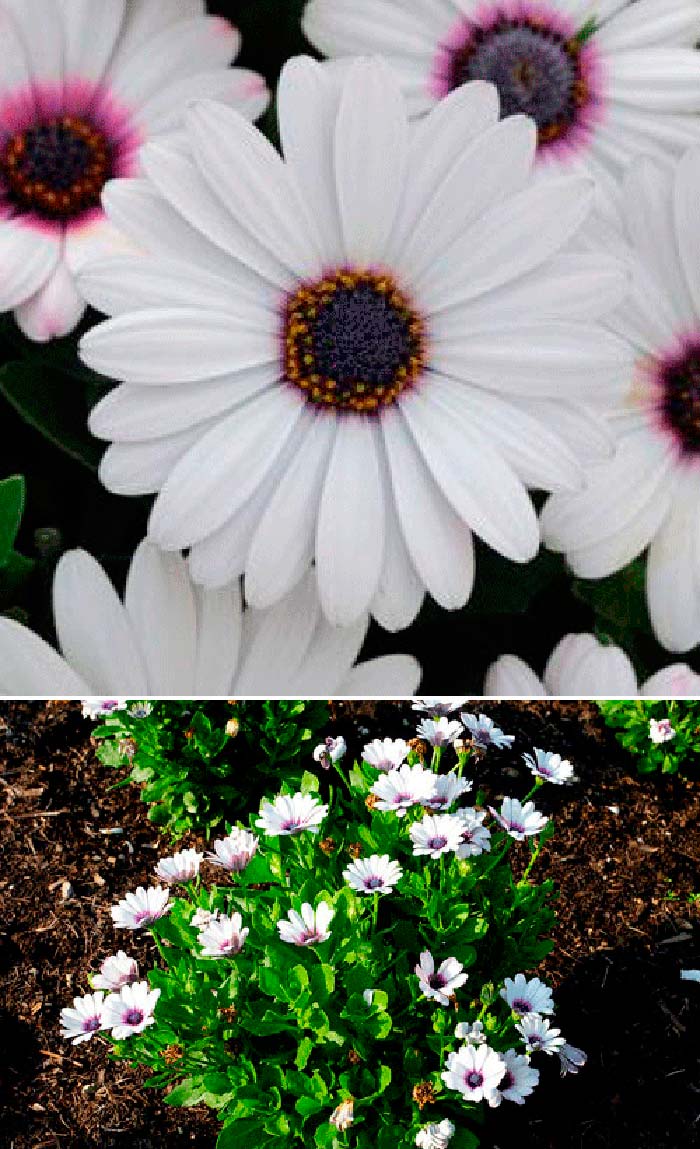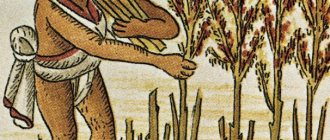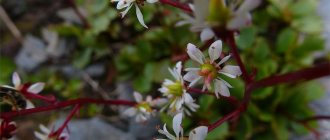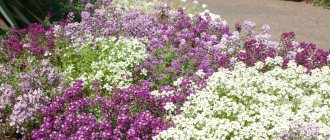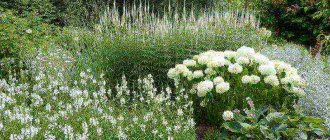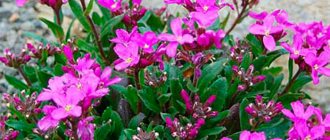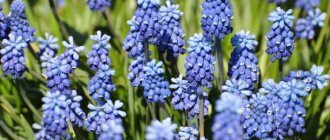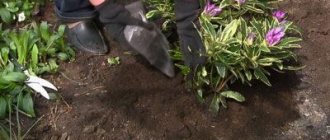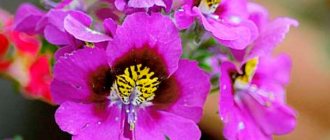In this article, you will learn how to grow osteospermum from seeds, what conditions it needs, when it needs to be planted, and much more. Osteospermum is a perennial flowering garden plant native to the African continent. The inflorescences resemble chamomile, hence the second name of the flower - African chamomile.
A popular way of breeding at home is growing osteospermum from seeds - the seed is germinated, and the mature seedlings are transplanted to a flower bed.
Description and features
Osteospermum is an evergreen plant that grows up to 100 cm high. Bushes have erect stems, but there are species and creeping. The edging of the leaf blades is unevenly serrated. The flowers are similar to baskets, 5-10 cm in diameter. They are lilac, pinkish, yellow, white, purple, blue or orange.
The plant differs from its relatives in that its median tubular inflorescences are sterile, and the seeds are tied with reed flowers. The culture is widely used to decorate patios, flower beds, and is grown in tubs and pots. Lush bloom ends only in November. Osteospermum is resistant to hot weather, dry periods, frost. In mid-latitudes, the crop is grown as an annual flower.
Planting seedlings in open ground
As soon as there is no threat of frost at night, the seedlings can be transferred to the garden. The optimal period is from the second half of May to early June. Specific dates can be found in the lunar calendar.
In the garden, they select a well-lit, sunny place where there are no drafts. The sun's rays are essential for the successful cultivation and breeding of osteospermum. In a shaded place, flowering will be scarce, the buds are small.
The soil should be light, loose, allow air to pass through, and have good drainage qualities. As for fertilizers, they are applied in the fall, using organic fertilizing.
Seedlings with a height of 20 cm with three formed leaves are transplanted into the soil. It is in such plants that the root system is sufficiently developed and easily adapts to natural conditions in the garden.
Osteospermum types
There are about 60 types of osteospermum. Each of them differs in flower color, size, frost resistance. Planting and care technology is the same.
Ampelny
The ampelous species is the most thermophilic of the Aster family. It needs to be covered for the winter, occasionally watered. The culture successfully takes root in pots on window sills, hanging flower beds.
Ecklona
Plants have straight shoots 0.5 meters high. The inflorescences in the form of baskets grow up to 8 cm in diameter, their middle is violet-scarlet, and on the lower part there is a mass of pinkish veins.
Shrub
The variety is distinguished by creeping shoots covering large areas. The bush grows up to 1 meter. The buds are ligulate, painted in a pale lilac or scarlet shade.
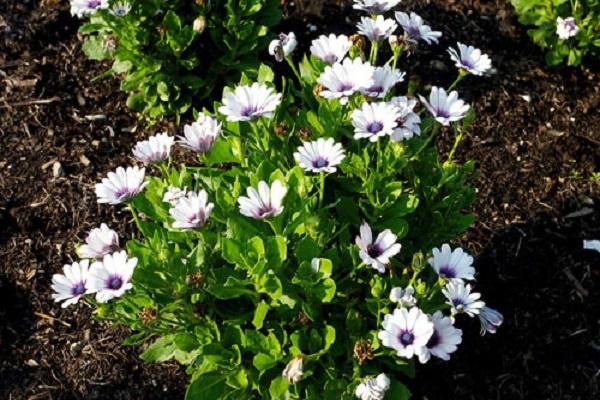
Conspicuous
The perennial blooms all year round, with ligulate inflorescences of a pinkish-purple tone. The color darkens towards the middle. The shrub grows up to 0.8 meters.
Terry
The variety is a well-leafy shaggy bush of emerald color. Purple buds with darkening towards the middle. The petals are corrugated, rounded towards the end, oblong.
Aquila
The Akila variety is a shrub from 41 to 51 cm. It is widely grown in pots, flower beds, ridges, as a decoration for a loggia or balcony. Inflorescences in the form of baskets, brownish-purple hue, placed on short stems. In the middle there is a black-violet color.
Cool
The variety shows resistance to frost, the bush grows up to 0.5 meters high. This is an annual bred by dimorphoteka. Panicles are white, deep purple in the middle. Stems and leaves are rich green, strong.
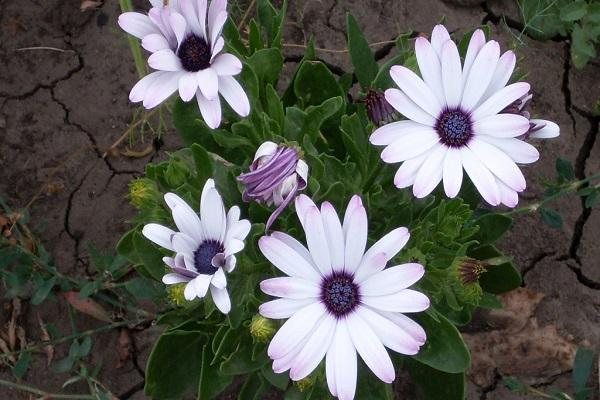

Bamba
Osteospermum Bamba is distinguished by wider inflorescences, unlike other species. When they bloom, the color is white, over time the shade changes to purple. Bushes grow up to 75 cm tall.
Mix
Osteospermum is grown as an annual plant due to climatic conditions. In warm countries, it is a perennial. Buds of various colors: lavender, pinkish, white, yellow. The bush grows compact, up to 0.4 meters high.
Passion
This is an annual, a low-growing bush that grows up to 45 cm. It is usually grown indoors, but you can keep the crop in vegetable gardens. Flowers of different tones: pinkish, lavender, purple and white.
Buttermill
Shrubs grow up to 0.6 meters tall. The cast is greenish-gray, and the inflorescences are light yellow, darkened towards the middle.
See also
Description and characteristics of the Delft Lace variety astilbe, planting and careRead
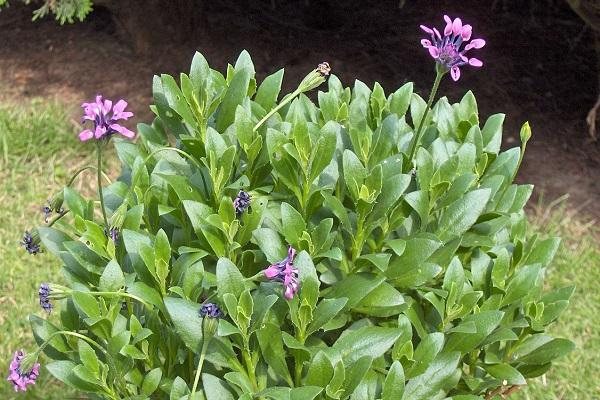

Congo
The buds of the osteospermum of the Congo variety are small, 4 cm in diameter. The flowers are purple-pinkish, and the stem and leaves are bright green. The bush grows up to 0.4 meters tall.
Zulu
This is a popular hybrid that is used to decorate home gardens. It differs from its counterparts in rich yellow flowers. The plant looks like a calendula. The height of the bush is approximately 0.5 meters.
Volta
The hybrid changes color during development. The petals are initially pinkish with a lilac tone, then turn white. The bush grows up to 1 meter tall. Leaves and stem are erect, rich green color.
Silver sparkler
The plant reaches 0.4 meters in height. The buds are white, the leaves have dots of a light shade.
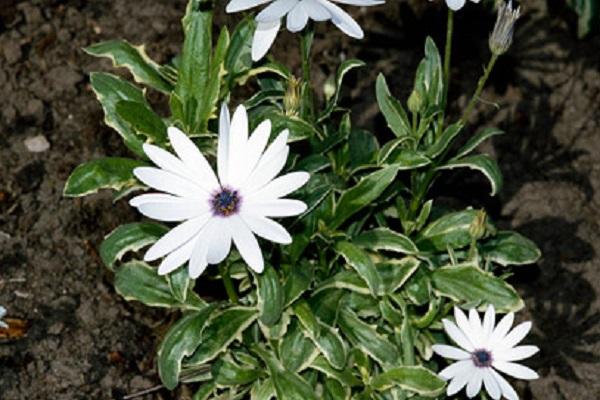

Cannington Roy
Low-growing creeping bush, emerald color. The diameter of the baskets is 8 cm, they contain white corollas, the tips of the purple color. Over time, they become purple-pinkish.
Pemba
The buds of the variety grow together into a tube to the middle, lilac color. The stem and leaves are turquoise, small. The bush grows up to 0.5 meters in height.
Lusaka
Inflorescences are ligulate, pale purple in color. The height of the shrub is about 75 cm.
Sandy Pink
The bush grows up to 0.4 meters in height. The baskets are pinkish, the shape of the petals is like a spoon.
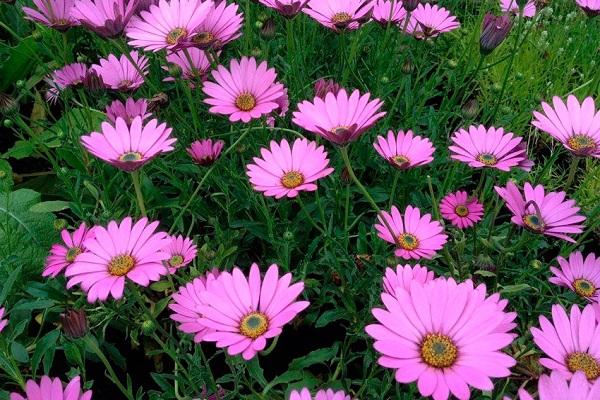

Starry Eyes
The plant reaches 50 cm in height. The lower part of the reed flowers, folded in half lengthwise, is bluish-gray. The top of the inflorescences is white.
Mix of colors
The annual variety is a bush that grows up to 25 cm in height. Inflorescences with a diameter of 5 cm, different tones: lavender, white, cream, pinkish. Leaves are glossy, rich green.
Ballad
The annual grows up to 25 in height, the bush is abundantly covered with lavender and purple flower-baskets. Inside are orange or gray-violet centers. Leaves and stem are deep green.
Parple
This is a low-growing variety, the bush reaches 16 cm in height. Buds up to 6 cm in diameter, densely cover the plant. They are purple in color with an orange center.
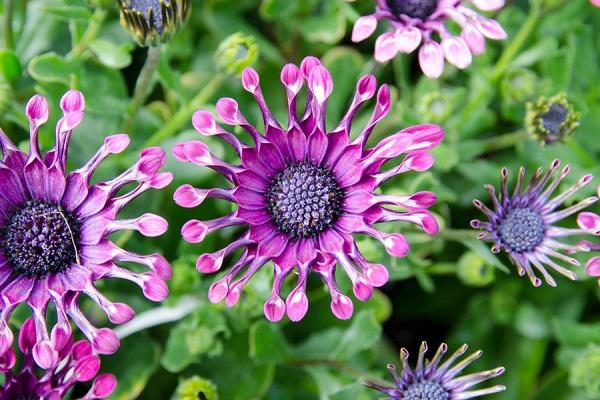

Grand Canyon Mix
The shrub grows up to 16 cm in height, covered with small inflorescences with a diameter of 6 cm. The color of the flowers is white, pinkish, lavender and light yellow.
White
The flowers are white, with a dark purple hue in the middle.The height of the bush is about 30 cm, it is usually grown in pots.
Sky and ice
The plant is painted in 2 colors - white and blue, according to the name. The middle of the inflorescence is blue, with whitish petals. The height of the shrub is 75 cm, the leaves and stems are emerald green.
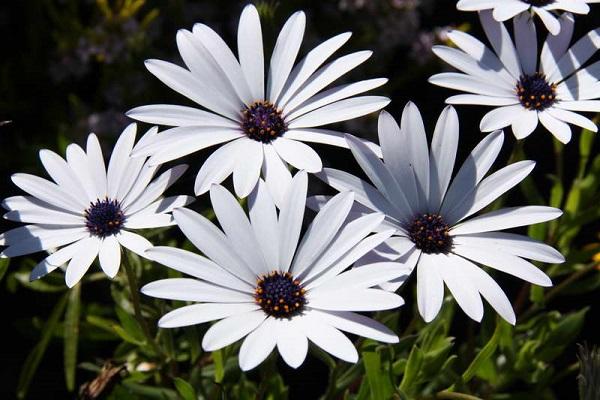

Mr. Dachnik recommends: ideas for the location of Cape chamomile in the garden
The plant looks great both in the landscape of large and small gardens. Planted as a curb plant, combined with stone compositions, also suitable for mixed flower beds and mixborders. Unpretentious appearance makes the plant versatile, combined with a large number of species and varieties of plants.
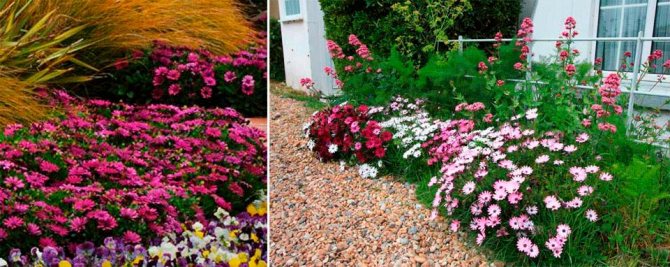

Used to decorate lawns, will attract attention and a lonely bush. Compact varieties are suitable for planting in a pot, for hanging planters, balconies and terraces. It will not be superfluous to tie up the stems if the splendor of the bush does not allow it to keep its shape. Dwarf varieties can be used as soil plants. Osteospermum in white tones will create a wonderful composition with lavender, Iberis, forget-me-nots and petunias.
Cultivation and care of osteospermum
Osteospermum should be planted according to the scheme, observing the correct time and place. It is easy to take care of the crop, you only need timely watering, treatment from pests, fertilization, and loosening of the soil.
Seat selection
It is advisable to plant the plant in a loosened area well-lit by sunlight. In the shade, it also takes root, but the bloom will be short-lived.
Preparing the soil for osteospermum
Before planting, fertilize the soil with humus, sand and sod land. The components are taken in equal proportions. Prepare the soil in 2-3 days.
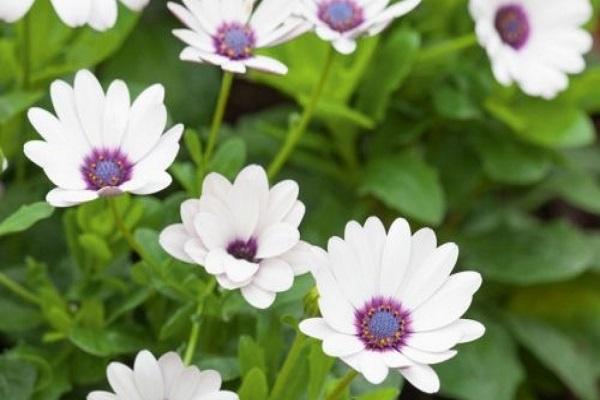

Landing
Before planting, they dig up the soil with a depth of 30-40 cm in the flowerbed, improving its structure. The soil will be saturated with oxygen, the plant will take root better.
The distance between the bushes should be 25-35 cm when planting medium varieties. Place low-growing plants at a distance of 10-15 cm from each other. Tall species of the Cool type are planted at a distance of 40-50 cm.
Seedling material is transferred with an earthen clod into the pits. Sprinkle the young plants on top with potting soil. It is made from such substances: humus, sod and leafy soil, sand in equal proportions. The surface of each groove should be tamped.
Watering osteospermum
The planted seedlings should be watered abundantly at once, 0.5 buckets of water are taken for 1 bush. Next, irrigate as the soil dries up, usually 2-3 times a week. Do not overmoisten the soil, this is fraught with rotting of the root system. Drought is also dangerous, the flower withers, and it will be impossible to revive it. Pouring water to pour the settled, as the ice liquid stimulates the folding of the petals.
See also
Description of astilba varieties Diamant, planting and care, wintering and reproductionRead
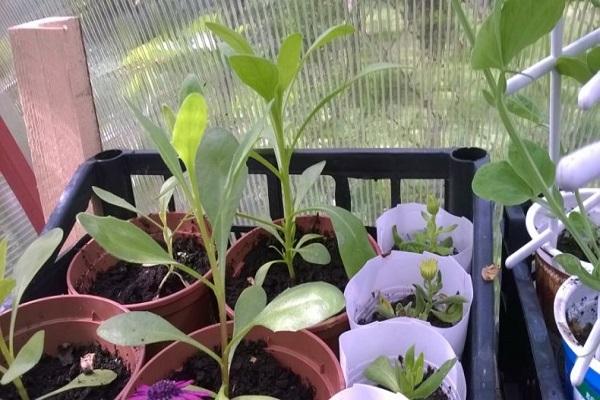

Topping
Pinch the tops to increase the density of the bush. The procedure is carried out 2-3 times during the life of the bush. Pinch off 5-7 cm of the upper stems using a disinfected secateurs. It is also important to remove withered or dried flowers.
Diseases and pests
Osteospermum is not attacked by most insect pests common in mid-latitudes, a similar situation with ailments. Excessive moisture can harm the shrub, which provokes rotting of the roots. In this case, the bush should be treated with fungicides.
It is not always possible to cure the plant, so it is worthwhile to take preventive measures in a timely manner that will help maintain the health of the shrub. Disease prevention includes:
- Timely weeding;
- Proper storage of seeds;
- Regular monitoring of the pH of the soil, both too low and excessively high levels of acidity are unacceptable;
- Constant weeding, proper moisture;
- Maintaining looseness of the soil;
- Cleaning of residual plant fragments, it is important to prevent them from overwintering in the ground.
In the absence of other sources of food, the aphids will eat osteospermum. Yellowing and falling leaves will be typical symptoms. To get rid of the pest, it is enough to spray the bush with insecticides, alternative methods are also suitable, for example, soap solution. To make it, you need to take 1-2 glasses of ash and pour 10 liters of boiling water from 1/7 of a standard piece of laundry soap, which must be pre-crushed into shavings. Then leave the solution to infuse overnight. Sift through cheesecloth before spraying. Excellent for protecting young plants.
Self-cultivation of osteospermum seedlings at home
Seeds should be sown on seedlings in late March or early April. Peat tablets or pots filled with a combination of peat and sand are used. In order for the seedlings to appear faster, it is better to place them in a moistened napkin for 2-3 hours before sowing.
It is necessary to lay out one seed on a damp surface of the earth with a toothpick, deepen it 0.5 cm into the ground. They are placed in a warm place with a temperature of 20-22 degrees Celsius. The first shoots will appear after 7 days, after which they are placed in a well-lit place. If seedlings are planted in a container, they form 2-3 true leaf plates. Then a pick is carried out. When high varieties are grown, they are pinched before transplanting in order to obtain profuse flowering in the future.
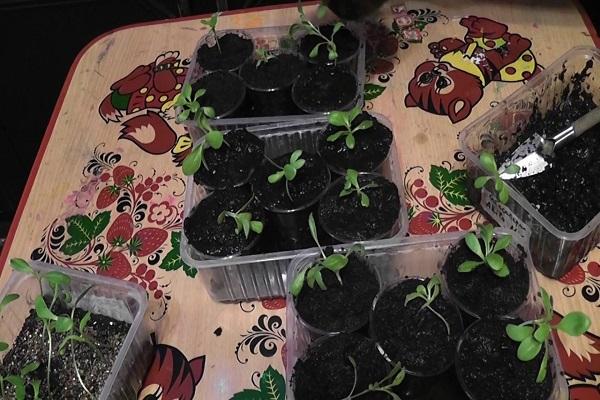

Soil preparation
The soil in the pot should be loose, moist. Experienced gardeners recommend growing seedlings in peat containers.
Hardening
It is necessary to start hardening the seedlings in early May. In the room, the window is periodically opened or the seedlings are taken out onto the balcony. For the first days, they should be outdoors for 15 minutes. Then the period is increased. Before planting, the seedlings are outside on daylight hours.
Timing of planting osteospermum in open ground
Seedlings are planted in a permanent place after May 25th. The air temperature should warm up to 15-20 degrees Celsius, since the plant is exotic, loves warmth.
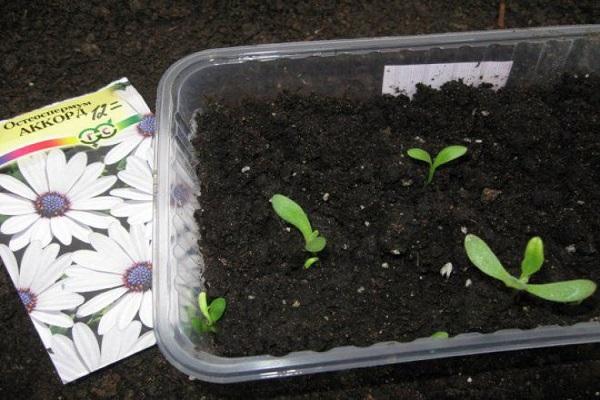

Seed preparation
The main requirement is that the seeds of osteospermum must be dry, they cannot be soaked. Otherwise, seedlings and seedlings will not be able to fully develop. Seeds that are wet are more likely to rot.
Before planting, the planting material is covered with a damp cloth for 15-20 minutes.
To increase germination, the seed coat needs to be slightly damaged. This can be done in several ways - lightly prick, rub with sandpaper, cut with a knife. Casing damage or scarification will ensure maximum germination.
Propagation by cuttings
Most of the varieties of osteospermum propagate only by cuttings. This is the most reliable method to preserve all the properties of the plant.
When sowing, there is a risk of producing flowers that differ from the desired variety. Petioles are taken from the top of the bush in February. They should be rooted within 1 month. The air temperature in the room should be +20. They are planted in pots.
If you plant the petioles in containers in the fall, and hide them indoors for the winter, they can become perennial.
Description of the flower
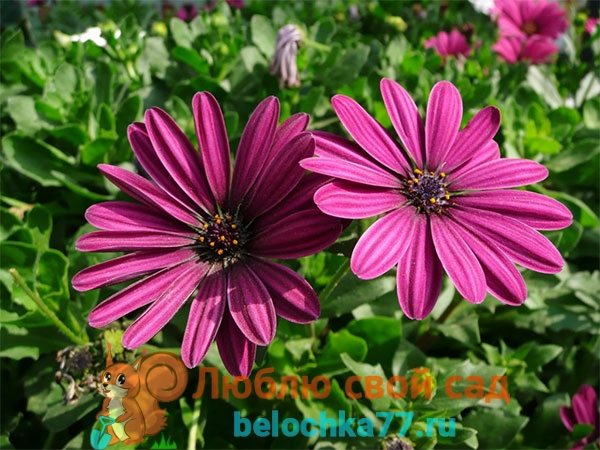

Congo variety
Osteospermum came to us from the countries of the African continent. But here the flower has taken root well, it has recently begun to be actively planted not only in home plots, but also in parks, squares, in city flower beds. This plant belongs to the Astrov family. Grows in the form of bushes with thick leaves and many flowers. Osteospermum begins to bloom in the middle of summer and continues until frost in the fall. Each flower reaches 5-8 cm in diameter. The color and shape of the petals of osteospermum depends on the variety, of which there are a lot.The bushes can be from 25 cm to 1 m high. When the leaves or stems are damaged, the flower emits a rather unpleasant odor that some people do not like. But during flowering, if there is no damage, this smell does not appear.
Harmful insects and pathologies
The flower is famous for its high resistance to diseases and harmful beetles, but sometimes they overtake the culture. If it blooms in the shade, is watered abundantly, the immune system weakens. This entails fungal infections. The rhizome rots, the plant dries up. Affected specimens should be treated with fungicides.
Aphids still appear on the leaves, sucking the juices out of them. The plant acquires a yellow color, the leaves fall off. For the destruction of insects, they resort to Aktar, Karbofos, Aktellik.
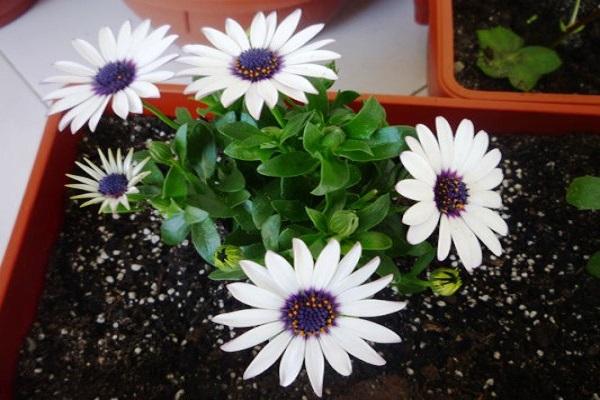

Types and varieties with photos
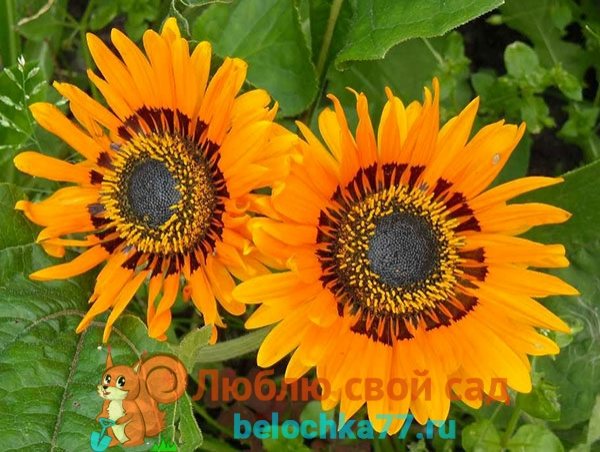

Zulu variety
Today, about 7 dozen types of osteospermum are known. But not all of them are cultivated here. The most popular can rightfully be called the Eclona osteospermum. Its second name is Carpathian Daisy. This shrub is a thermophilic perennial that is often grown as an annual in colder regions. Today, many varieties have been bred on the basis of this species. They differ in shape and color. Here are the most popular ones:
- Silver Sparkler has white flowers and green leaves with white spots;
- Buttermilk has bright green leaves and yellow flowers;
- Zulu has a delicate shade of yellow flowers;
- Congo blooms in the form of flowers with a pinkish-purple tint.
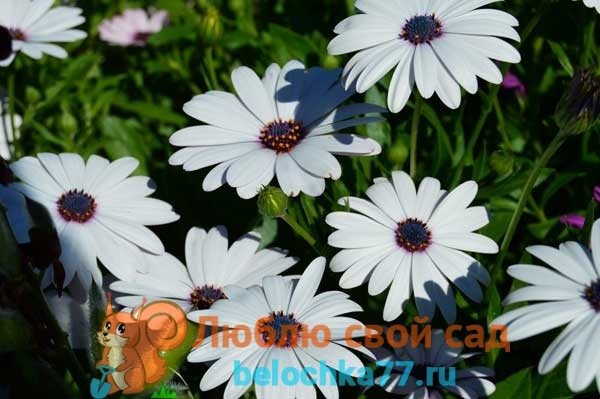

Silver sparkler variety
Another type of African chamomile, which appeared in our country not so long ago, is conspicuous osteospermum. Its main distinguishing feature is the variation in color during flowering. As the flower blooms, its hue changes, and this also happens at the end of flowering. For example, the Volta variety turns white after it blooms in lilac-pink tones. But Bambe, on the contrary, first has a light color, and then turns purple.
Gardeners most often use undersized varieties, which allows osteospermum to be planted not only in open ground, but also in containers and pots.
Forum, reviews
Flower forums are full of photos and video reports of satisfied flower growers. After all, the bush not only pleases with its buds throughout the season, but is literally covered with inflorescences. Amazing colors make the flower bed a work of art.
According to reviews, the main problem of a flower is its reaction to the amount of moisture. It is necessary to slightly increase the volume of liquid, and the plant immediately begins to rot. Some growers fail to collect seeds from an existing specimen and have to re-buy the African beauty.
Possible growing difficulties
Diseases and pests rarely attack the Cape daisy. In most cases, the flower is resistant to disease. However, the reason for the decrease in the protective properties can be the growth of the bush in unfavorable conditions.
Remember! Compliance with all the rules and norms of flower maintenance is a guarantee of healthy growth and protection from pests.
The most detrimental factor is waterlogged soil, which cannot dry out. If the planting was carried out in a shaded area, then you should worry about the health of the plant. With a lack of sunlight, the soil dries out poorly, which becomes a favorable environment for the development of a fungal infection. If the fungus hits the bush, then the root system will rot, the greens will begin to wither, and the plant itself may even die.
Only timely measures can be taken to save the species. The culture is transplanted to a more illuminated place with nutrient soil. After removing the plant, the roots must be treated with special antifungal agents.
Aphids like to feed on the juice of a weakened plant. Basically, aphid families settle on stems and foliage. In this case, the greens begin to turn yellow and fall off.The bushes begin to ache and wither. To combat aphids, it is recommended to spray with insecticides. Some growers use a solution of laundry soap or garlic water for processing.
If in the summer heat the bushes stop flowering, do not panic. In a period of extreme heat, such a reaction is understandable. As soon as the air temperature begins to drop, the plant will regain its vitality and resume flowering.
Can it be grown as an indoor flower?
To grow African chamomile in a pot on a balcony or in an apartment, it is necessary to provide favorable conditions. Loose fertile soil, universal soil should be purchased. Self-preparation of the mixture:
- sand;
- leafy land;
- sod;
- humus.
Containers must necessarily have drainage holes for excess water. At the bottom of the flower pot, expanded clay is poured as drainage. An indoor plant can keep flowering for up to eight months. It needs rest. The pause is arranged in December and ends in early March. It is important to move to a dimly lit, cool place. Cut watering.
Planting seedlings
To obtain a bright and long-lasting flowering, seedlings need to be planted in a sunny place of the site, since hot Africa is still the homeland of this plant. A light partial shade may also work, although in this case the plants will stretch strongly and, as a result, not such a compact bush will grow as originally planned. Make sure that the soil on the site is sufficiently nutritious and loose, but do not overdo it when fertilizing - the plant does not like this, as well as excess moisture.
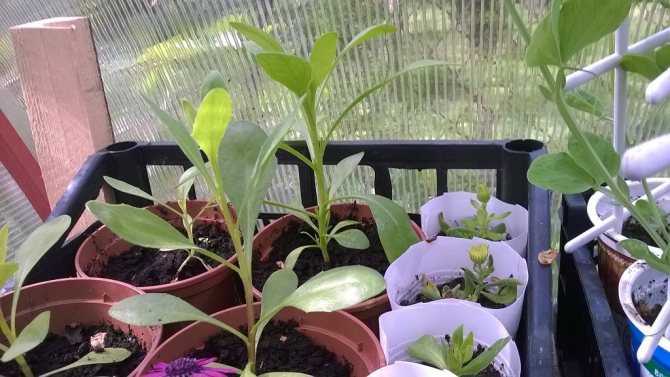

Seedlings of osteospermum
On a note! You need to start planting seedlings only after the threat of night frosts has passed. In theory, osteospermum can withstand rather low temperatures (down to -5 ° C), but risking is undesirable, because you can lose plants.
After waiting for a suitable warm day, prepare the holes for seedlings, and then move the seedlings into them along with the earthen clod. Then gently compact the soil and water the plant with warm water. When transplanting, try not to damage the measles system. The optimal distance between seedlings is 35-40 cm.
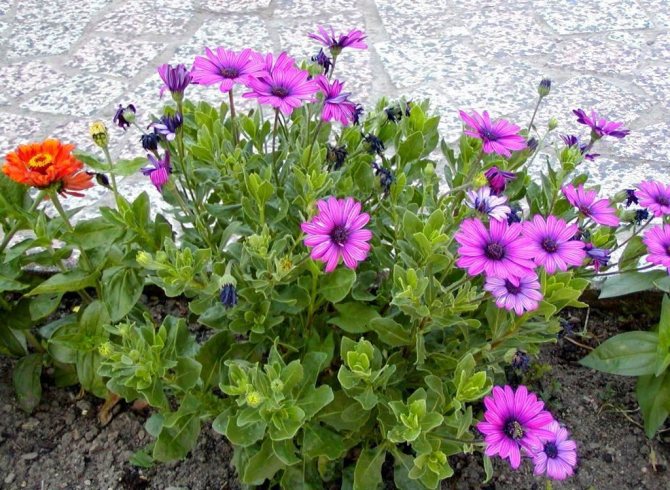

Osteospermum in a flower garden
Summer flower care


The unpretentiousness of the flower lies in the fact that it can endure various unpleasant conditions. African chamomile will survive with insufficient watering, hot weather, wind and even mild frost. Fertilizing a flower is often worth it - every week. It will improve growth, appearance. The plant will bloom for a long time and abundantly.
You need to weed the bushes only at first, until they grow up. When the leaves close in the rows of osteospermum, there will be no need to loosen or weed the soil.
To give the flowers a beautiful shape, it is advisable to pinch the bushes. Thus, the plant will be more dense, branched. During the season, this procedure is done at least twice. Also, the complex of measures for the care of osteospermum includes the elimination of flowers that have withered and dried out.
Turkish carnation - growing from seed, when to plant
Common unpretentious varieties of osteospermum
Every grower is interested in the question of whether osteospermum is perennial or annual? It is a perennial evergreen, but in the climate of the middle zone it is cultivated as an annual.
In osteospermum (Osteospermum) inflorescences are simple, semi-double and double.
Consider a few common hybrid osteospermum varieties.
The "Sky and Ice" variety is very popular. The mesmerizing contrast of snow-white petals with a blue center reminds romantics of snow-capped mountain peaks against a blue sky. Reaches a height of 75 cm.
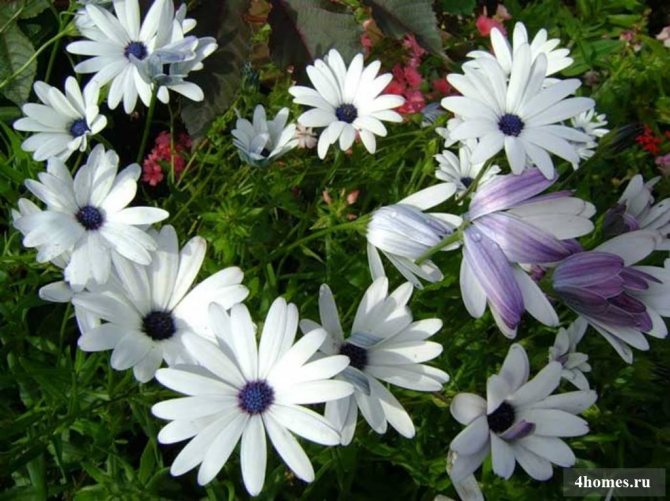

At Pink Sand, the delicate pink color of the petals gradually intensifies as it approaches the edges. Reaches a height of 60 cm.
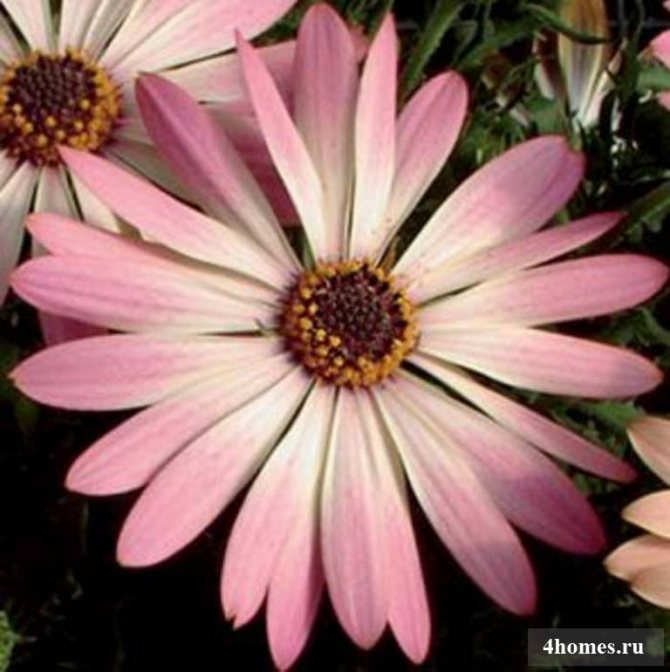

Flower Power Spider White-Purple amazes with unearthly beauty. Its height is 45 cm.
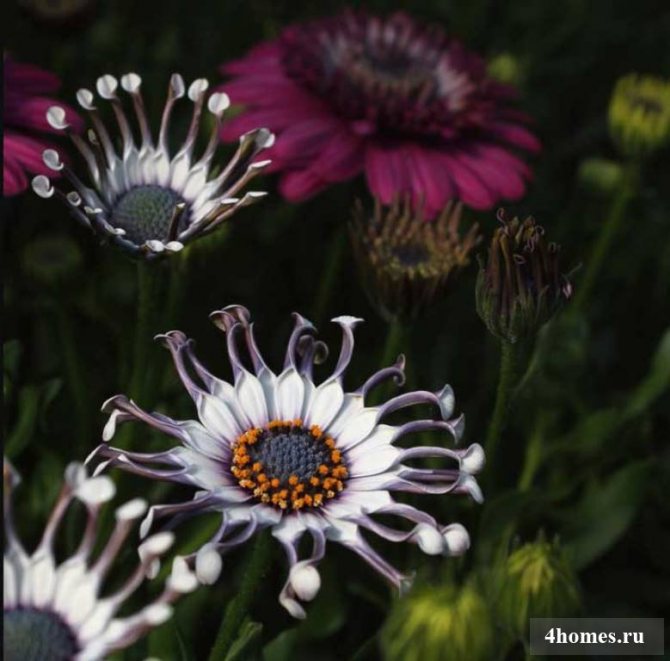

Beautiful double variety Flower Power Double White with mauve center framed by white large petals.
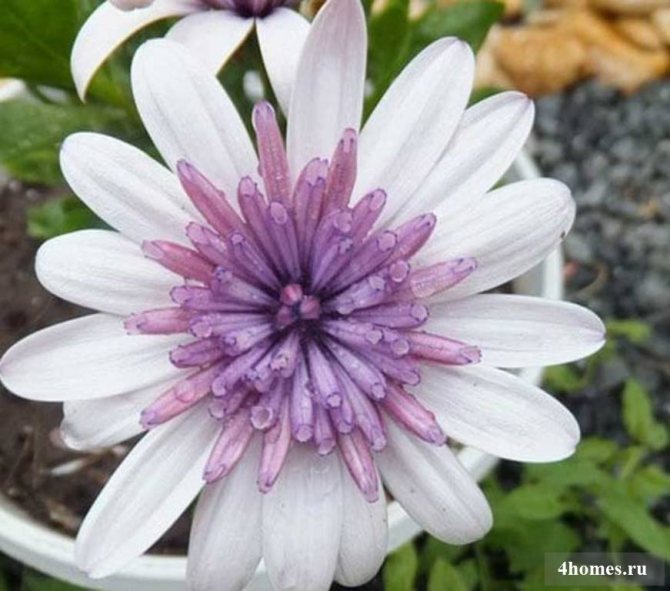

Cheerful Double White Lemon with large snow-white outer petals and a yellow center.
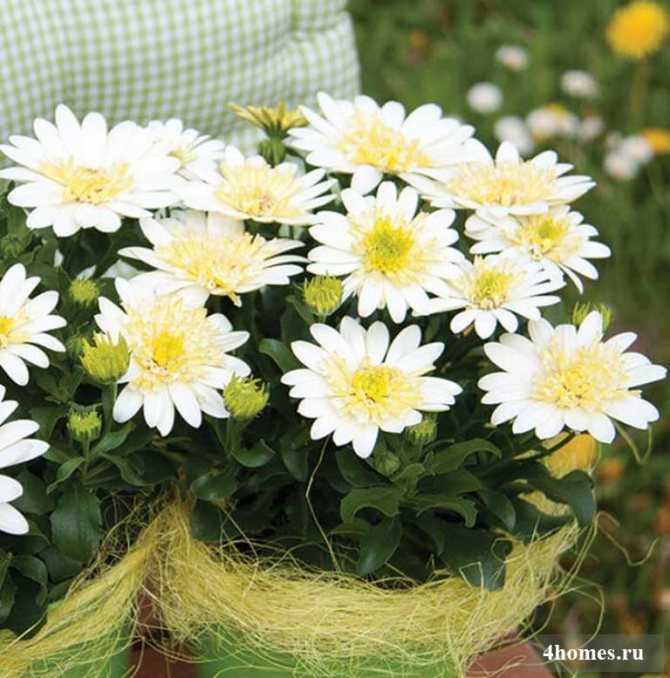

This is just a small part of the existing varieties! The opened inflorescences can be admired in sunny weather, the rest of the time they are closed. Only some terry varieties remain always open.
Each flower lives only 5 days, but by the time it withers, others appear. Flowering peaks in July and August. But with a warm autumn, osteospermum is able to bloom in October, tolerates the first frosts.
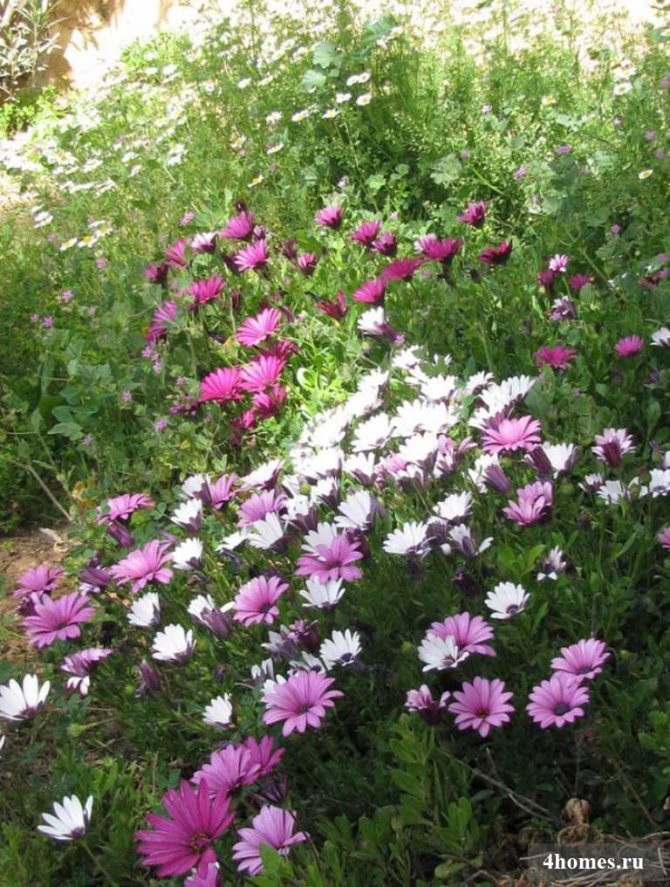

Osteospermum in landscape design
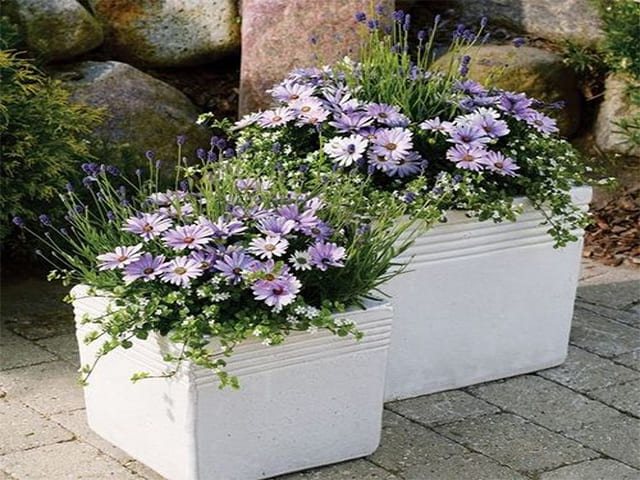

Daisies with lush colors, attractive bush shape are desirable in any flower garden. Against the background of paved paths, planting in groups looks spectacular from different varieties, along curbs, in the middle of lawns, in a flower bed. Low varieties are suitable for ampel growing or creating a bright creeping carpet. Dwarf flowers in flowerpots are capable of complementing the interior.
Attractive versatility is equally good on slopes, rocky hills, areas with poor soil. Favorably combined with many sun-loving, erect flowers and herbs. It stands out especially against the background of verbena, petunia, lantana, sage, pelargonium, bell, geranium.
The main thing is compliance with similar requirements for growing conditions. Due to the wide growth and branching, it is recommended to maintain a distance between the bushes of thirty to fifty centimeters. The requirements are based on the variety of varieties.
Plant features
There are other names for this wonderful flower - Cape daisy or Cape daisy. Osteospermum is often confused with chamomile due to its appearance (it refers to the shape of the petals and flowers). Despite the hot homeland of the plant, it is now grown almost everywhere. The list of exceptions should include only the northern regions with a cold climate.
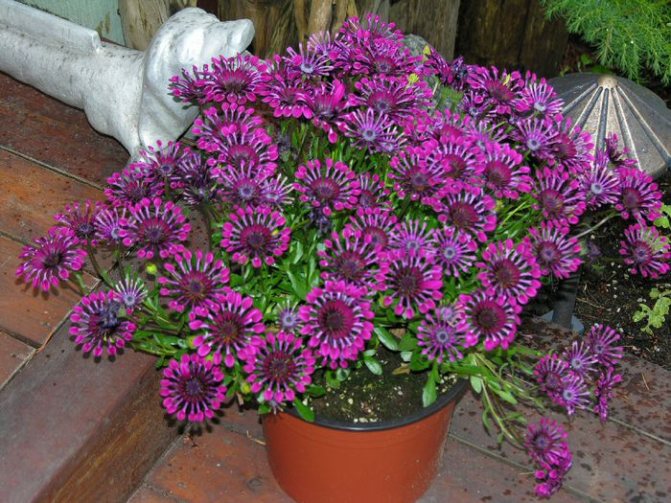

Osteospermum is a plant that blooms for a long time and is popular in the design of many places.
A lush osteospermum bush with a lot of leaves is decorated with delicate and beautiful flowers that begin to bloom from the first half of June. The diameter of the flower rarely exceeds 5 cm. This is a chamomile-like inflorescence, the ligulate flowers of which can have a different color, depending on the type of plant or its variety. These flowers take part in the formation of seeds. The color of the central tubular flowers can range from bright blue to dark blue, but they themselves are sterile.
On a note! The leaves of osteospermum, which have a bright green color, are distinguished by their specific smell, which may not please everyone. In addition, if the crop is damaged, this unpleasant odor increases.
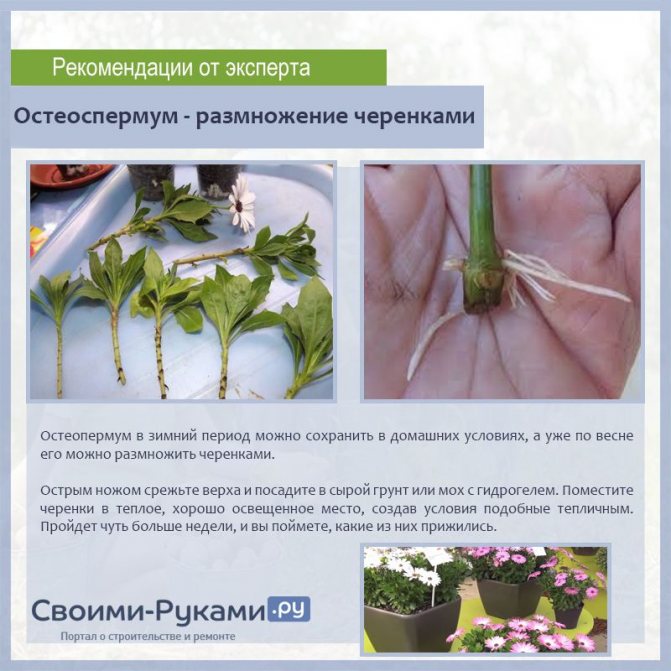

Osteospermum - propagation by cuttings
1. Seven Secrets of Success:
| 1. Growing temperature: can be grown throughout the year at normal room temperature in the range of 18 - 24 ° C. |
| 2. Lighting: Well-lit location with access to direct sunlight in the morning and evening and light shade during daytime. |
| 3. Watering and humidity: uniformly moistened soil during the growing season - in spring and summer, autumn and winter, limited irrigation with water at room temperature and a sufficiently high air humidity. |
| 4. Pruning: formative - regular pinching of the tips of young shoots, sanitary - removal of old and diseased branches, it is also necessary to remove fading flowers. |
| 5. Priming: loose texture, organically rich, with good drainage and acidic pH. |
| 6. Top dressing: in spring and summer, they are fed with mineral fertilizers 2 times a month, when kept warm in autumn and winter, fertilizing is carried out every month. |
| 7. Reproduction: stem cuttings in spring and summer, seeds - a rather long process. |
Botanical name: Osteospermum.
Osteospermum flower - family... Compositae or aster.
Origin... South Africa.
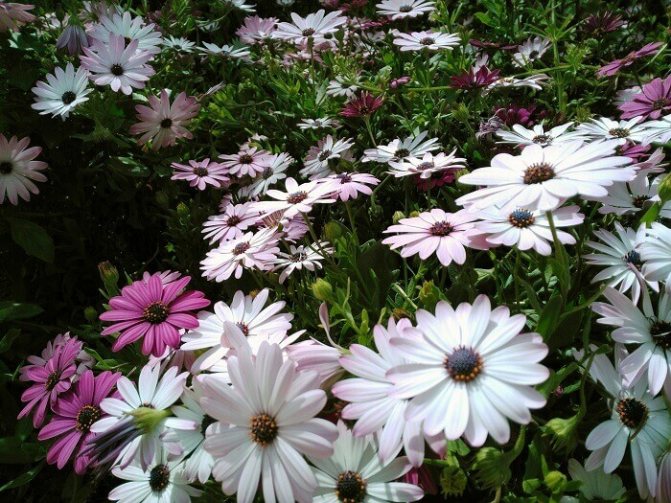

Description - what the plant looks like... Osteospermums or African chamomile are biennial or perennial herbaceous plants that are pleasant in all respects.
Leaves green, often long and narrow, the leaf blade has small denticles.
Flowers large, solitary, with a dark center, appearing at the tops of long, slender stems. In fact, the flowers are inflorescences consisting of very small tubular flowers. The petals of some species are often twisted and look rather unusual. Shades of flowers are very diverse and range from white to pink, orange, blue, purple, salmon, red. When damaged, the leaves and stems give off an interesting aroma.
Currently, dimorphoteka and osteospermum are often confused - they are close relatives, but it was decided to call perennial plants osteospermums, and annuals - dimorphoteka.
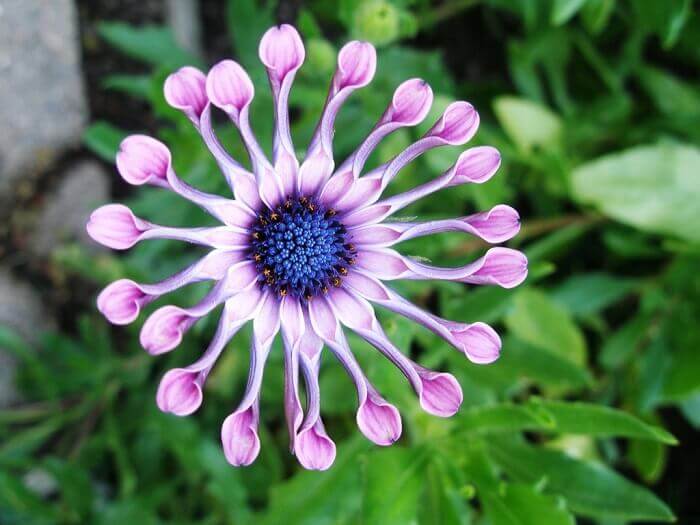

Height... For growing indoors, low-growing species are suitable, whose height does not exceed 15 - 60 cm.
Autumn care
Important nuances:
- the fruit is a box;
- seeds with pointed ends, brownish brown;
- large grains are rarely used for reproduction of Osteospermum: signs of the parent bush are rarely preserved;
- in October, for convenience, the stem and leaves are cut in half, the plants are taken out of the ground, disposed of, the soil must be dug up;
- if the florist decided to grow the Cape chamomile as a perennial, then you need to dig out the bush while maintaining the integrity of the roots, plant it in a flowerpot, transfer it to a cool room, provide care, and in the spring again transplant it to the site;
- they dig up the soil in any case: a simple agricultural technique allows you to destroy the larvae of harmful insects that cannot stand low temperatures.
Wintering
A heat-loving plant does not tolerate frosts well, and it is undesirable to leave Osteospermum on the site even in a "mild" winter. Some growers decide to experiment, and in some cases, in the absence of frost, the plant remains viable, and active vegetation begins in the spring.
The best option is to buy a new planting material for sowing seedlings. In the fall, you will have to dispose of faded plants, carefully dig up the soil, in the spring, plant young seedlings obtained from seedlings.
How to grow a perennial? Some flower growers dig up African chamomile, transplant it into a flowerpot, keep it in a cool room in winter, at a temperature of +7 to +14 degrees. During the wintering of Osteospermum in an apartment, you will need good lighting, minimal feeding once a month, and occasional watering so that root rot does not develop. In the spring, a thermophilic view of the site is planted again.
Favorable conditions for seed germination
Growing osteospermum from seeds involves creating favorable conditions to accelerate the emergence of seedlings:
- temperature + 20 ° С;
- protection from drafts;
- periodic overturning of glass or film for fresh air;
- spraying the soil with warm water as it dries up;
- good lighting.
When these conditions are met, osteospermum seedlings will appear in 8-12 days. When the flower begins to sprout, it is provided with natural light. In conditions of short daylight hours, phytolamps are installed above the seedlings. They are turned on in the morning or in the evening so that the osteospermum is illuminated for 12 hours.
How to prolong flowering
Osteospermum blooms from June to mid-autumn. To extend the flowering period, dry flowers are regularly pruned.


Photo: <>
Fertilization based on iron chelate helps to increase the flowering period. Fertilizer is in the form of tablets or mother liquor. 5 g of iron chelate are added to 10 liters of water.The resulting solution is sprayed with osteospermum during the formation of buds.

